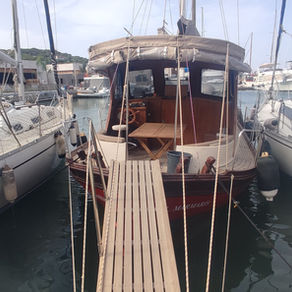Restore, Protect, and Shine: Erase the Effects of Time and Sea on Your Boat’s Rigging and Deck
- marmaristms

- Jul 31
- 2 min read
Mast, Boom, and Spinnaker Pole Surface Preparation Process
Following the completion of the mast disassembly, detailed surface preparation is being meticulously carried out on the mast, boom, and spinnaker pole surfaces. The procedures that have been followed and are ongoing in the surface preparation are as follows:
Initial Cleaning: Residues such as oil, dirt, salt, and old paint on the surfaces have been completely removed using solvents and special cleaners. Where necessary, high-pressure water and chemical cleaning methods have been utilised.
Sanding: Old paint layers, rust, and blistered areas on the surface have been thoroughly cleaned using mechanical or manual sanding tools. Especially on metal surfaces, sanding started with P-80 grit and continued with P-400 to P-1200 grit sandpapers before and after priming.
Surface Repair: Any rough, indented, or cracked areas revealed after sanding have been repaired using technically appropriate filling compounds and/or epoxy fillers. The areas treated with filler have been sanded again to achieve a smooth surface.
Dust Removal: Following sanding and filling, surfaces have been meticulously cleaned with antistatic cloths, air blowers, or damp cloths to ensure no dust or particles remain.
Primer Application: An appropriate primer, selected for the surface type, has been applied completely as the first protective layer. At this stage, chemical and/or protective primers suitable for metal and aluminium surfaces have been preferred.
Sanding the Primer and Topcoat Preparation: As can also be seen in the video, after the primer dries, the surface is sanded again with fine sandpaper. Thus, optimum adhesion for the topcoat paint will be achieved, aiming for a beautiful and aesthetic finish.
Removal and Surface Preparation of Deck Fittings
In parallel, the removal of various fittings and equipment on the yacht's deck has begun:
All connection points, such as hinges and hardware, are being carefully dismantled and meticulously inspected for damage and deformation.
Deformations that have formed over time on the deck surface—such as blistering, cracking, or due to water infiltration—have been detected, and all old paint layers have been carefully removed.
Connection holes, deep scratches, or cracks on the surface will be reinforced with appropriate filler materials.
Afterwards, the deck will be sanded using the same methods to prepare it for new paint, and these related works are ongoing.
Other Details Observed During the Painting and Maintenance Process
Material and Equipment Selection: All sanding, filling, and paint products used have been sourced according to marine conditions and by the yacht's construction materials.
Occupational Safety and Compliance with Standards: All processes are being carried out in full compliance with occupational health and safety guidelines and manufacturer instructions, with the use of personal protective equipment (masks, goggles, gloves).
Coordination: Surface preparation, fitting removal, and painting works are being conducted in a planned and coordinated manner, which shortens the project time and maximises efficiency through teamwork.
To maintain the yacht's overall structural integrity and ensure maritime safety, painting work is ongoing for the mast, boom, spinnaker pole, and the entire deck. As the process progresses, regular updates will be provided in the same detail.









Comments